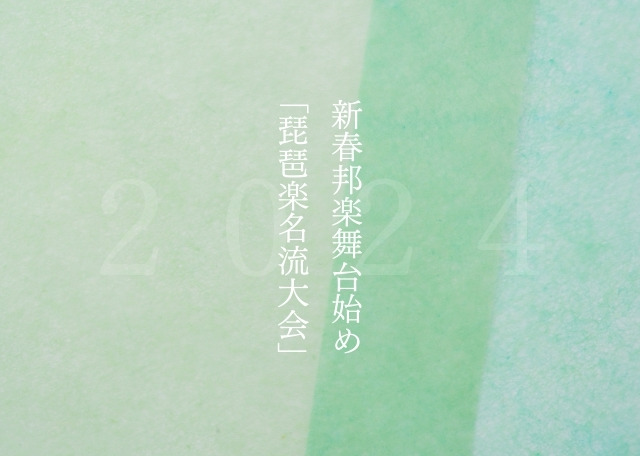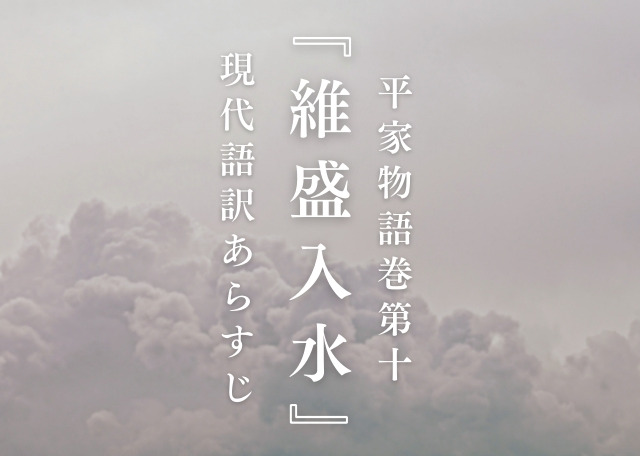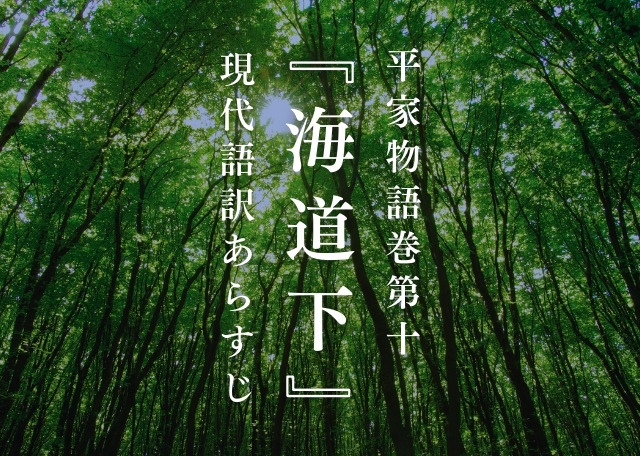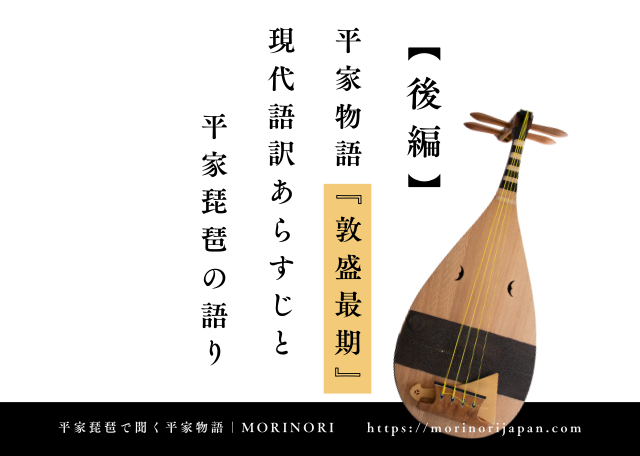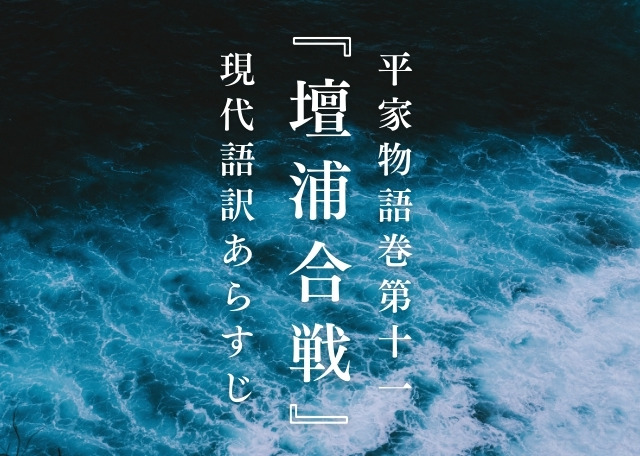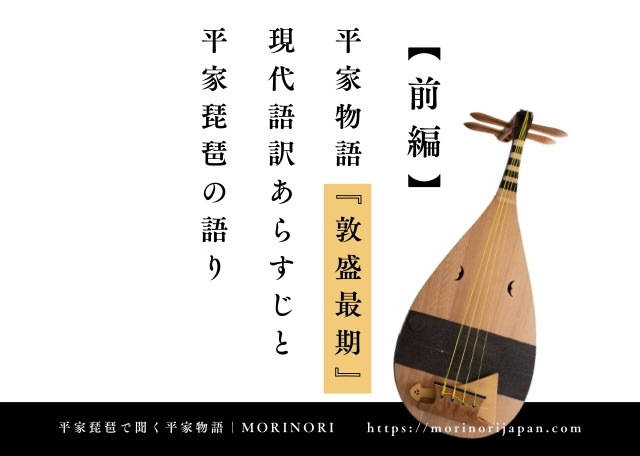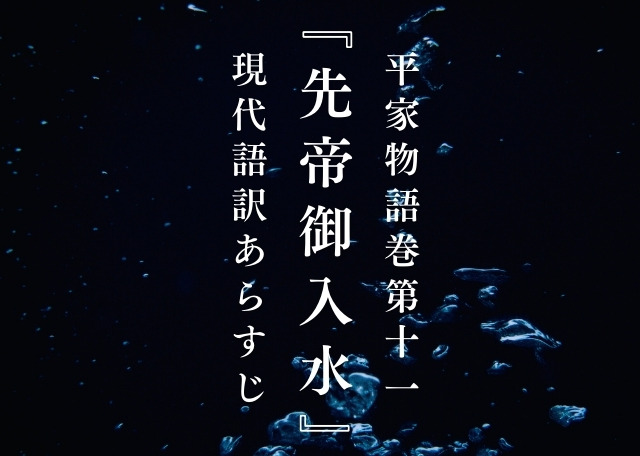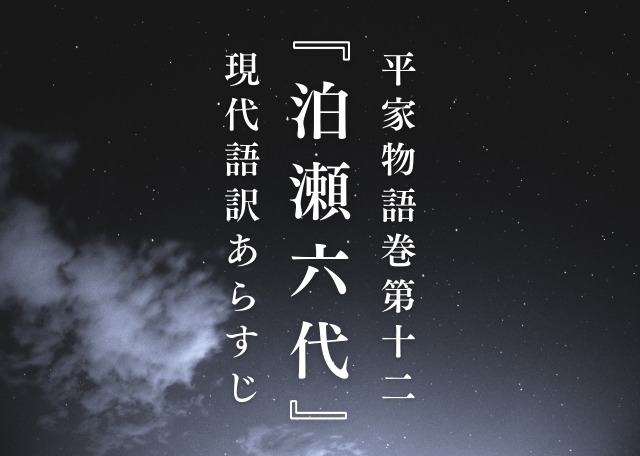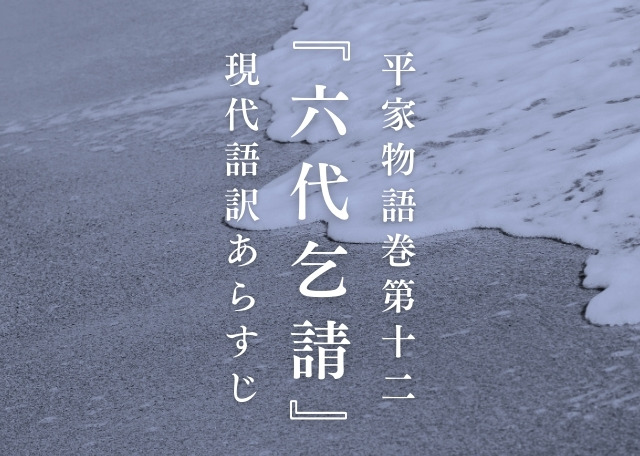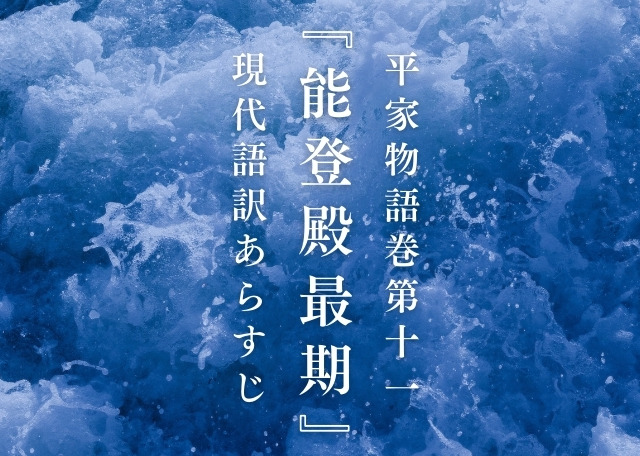Welcome to our site.
This is the website of MORINORI, which holds small Heikyoku (a performance of the Heike Monogatari accompanied by Heike biwa) concerts and lectures. On this page, we introduce a modern translation of the Heike Monogatari, Volume 10, “Yokobue”. It’s still a bit rough, but please take a look if you like. In addition, we will introduce a small Heikyoku performance “Off the coast of Nachi / The Tale of the Heike, listened to in one’s sleep by Heike biwa” in the second half of the page.
▼For first-time visitors
https://morinorijapan.com/welcome
▼Introduction to the program
https://morinorijapan.com/performance-lineup
▼Click here for a list of modern translations of the Tale of the Heike
The Tale of the Heike is performed at concerts and lectures, etc., in modern Japanese translation.
https://morinorijapan.com/category/tale-of-the-heike/
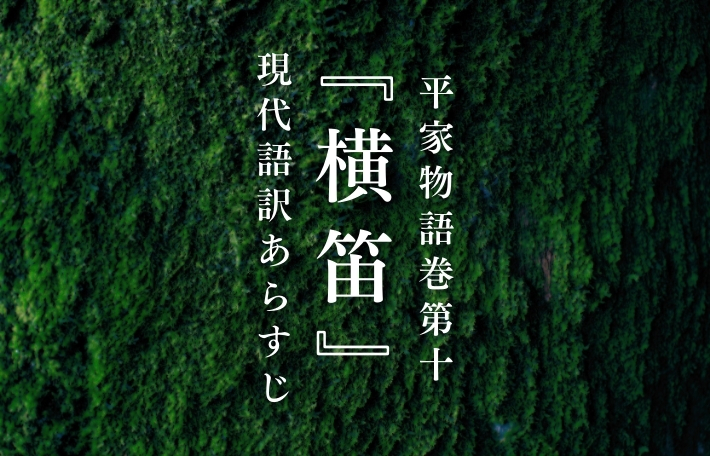
A simple summary of the Heike Monogatari, Volume 10, ‘Yokobue
Komatsuno sanmino chujo (Tairano Koremori) was in Yashima, but his heart was always yearning for the capital. Before dawn on the 15th day of the third month of the third year of the Juei era, he secretly left Yashima and set off for the Kii Road with Yosoubyoueshigekage, Ishidoumaru and Takesato, who rowed the boat. Although he was very keen to return to the capital, he remembered that his uncle Tairanoshigehira had been taken prisoner alive, and so he made up his mind to go to Koyasan, where Takiguchi Nyudo (Saito Takiguchi Tokiyori) was staying.
Takiguchi Nyudo was originally a retainer of Komatsudono (Shigemori, the father of TairanoKoremori), and when he was 13, he fell in love with Yokobue, who was working as a servant for Kenreimonin, but when his father warned him against it, he became a monk at the age of 19 and entered Ojoin Temple in Saga. Yokobue was saddened to learn of this, and set off for Saga, but Takiguchi Nyudo did not see her and sent her home. Later, Takiguchi Nyudo moved to Koyasan, and Yokobue also became a nun and lived at Hokkeji Temple in Nara, but she died not long after.
Takiguchi Nyūdō threw himself into his ascetic practices, and his father forgave him for his lack of filial piety. When the third chief minister visited Takiguchi Nyūdō, he looked completely different from his former self, gaunt and dark, like an old monk, but his devotion to his ascetic practices made him seem like a sage, and he seemed to be no less than the sages of old.
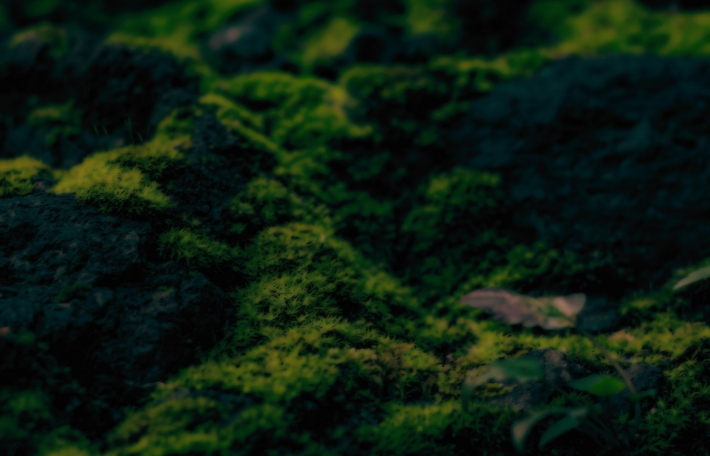
The Tale of the Heike, Volume 10, “Yokobue” – Modern Japanese translation – Full text
At that time, Komatsuno sanmino chujo (Tairano Koremori) was in Yashima, but his heart was in the capital. The image of his young children, whom he had left behind in his hometown, always came to mind, and he could not forget them. He lamented the fact that he could do nothing, and secretly left his mansion in Yashima before dawn on the 15th day of the 3rd month of the Juei era. He took Yosoubyoueshigekage, Ishidoumaru and Takesato, who rowed the boat, and set off from Yukiura in Awa Province, rowing past Narutoura and heading for the Kii Road.
After passing the shrine of Hime no Mikoto, the deity of the Japanese poem, and the shrine of Hime no Mikoto, the deity of the Japanese poem, and the shrine of Hime no Mikoto, the deity of the Japanese poem, and the shrine of Hime no Mikoto, the deity of the Japanese poem, and the shrine of Hime no Mikoto, the deity of the Japanese poem, and the shrine of Hime no Mik From here, she took a mountain path to the capital, hoping to see her loved ones again, but she thought it would be even more painful to be captured herself and to have to paint her father’s corpse with blood, when she was already feeling so ashamed of having been taken alive and humiliated in the capital and in Kamakura. He tried to go a thousand times, but each time he reconsidered and in the end he decided to go to Koyasan.
There was a holy (high priest) I had known for many years at Koyasan.
Saito Takiguchi Tokiyori, the son of Sanjo Saito Saemon Shigeyori, was originally a retainer of Komatsudono (TairanoShigemori). When he was 13, he came to Honjo, where he met a woman named Yokobue, who was a servant of Kenreimonin, and Tokiyori fell deeply in love with her.
When the father heard about this, he strongly admonished her, saying, “I had hoped to find a son-in-law who was a powerful figure in the world and would be able to perform his duties without worry, but you have fallen in love with someone of no status.” Takiguchi replied, “There was a person called the Queen Mother of the West in the past, but she no longer exists. I have only heard of a person called Dongfang Shuo, but I have never seen him. Life is like a flash of light, whether you are young or old. Even if a person lives a long life, they will not live past the age of seventy or eighty, and their prime will only last for a little over twenty years. If trying to see the beloved person would be against my father’s wishes, then this is a good teacher (Buddhist guidance). I want to leave this world and enter the true path.” At the age of 19, he cut his hair and entered Ojoin Temple in Saga.
Yokobue heard about this and thought, “I am resentful that he left me and became a priest. Even if he was leaving the world, why didn’t he tell me? I want to go and visit him and clear the air once and for all.” With these thoughts, he left the capital one evening and headed towards Saga.
It was a little over the 10th day of the second month, and the spring breeze in the village of Umezu made me nostalgic for the smells of the outside world, and the moonlight on the Oigawa River was wrapped in a haze, making it indistinct. I wondered whose fault it was that I felt such unbearable sadness.
I had heard that it was Ojoin Temple, but I didn’t know exactly which temple it was, so I rested here and stood there, unable to find it. I heard the sound of chanting in a deserted thatched hut, and the woman I was with said, “Even if things have changed, I wanted to see you, so I came here.” Takiguchi Nyūdō’s heart was pounding, and when he looked through the shoji screen, he saw that the hem of her kimono was wet with dew and her sleeves were damp with tears, and it looked as if even the most hardened of men would be moved to tears.
He sent someone out to say, “There is no one here by that name. Perhaps you have come to the wrong gate,” and in the end, he sent him home without meeting him. Yokobue felt sorry and resentful, but there was nothing he could do, so he went home, holding back his tears.
After that, Takiguchi Nyūdō told the other monks in the temple “This place is also quiet and secluded from the world, and it won’t interfere with my chanting of the Buddha’s name, but a woman I left behind with lingering feelings saw me living here, so even if I manage to keep my mind strong for a while, if I start to feel longing again, my heart will be disturbed. I would like to take
When he heard that Yokobue had also become a priest, Takiguchi sent him a poem: “Until I was shaved, I had nothing but resentment, but now I have entered the true path, and I am happy.” Yokobue replied, “Even if I am shaved, I have nothing but resentment. If I am to remain a catalpa bow player, I must have the heart to do so.”
After that, Yokobue was at Hokkeji Temple in Nara, but he died soon after, perhaps because his feelings for Takiguchi had grown too strong. When Takiguchi heard the news, he became even more deeply devoted to his ascetic practices. His father also forgave him for his lack of filial piety. All his close friends called him “Kōya Hijiri”.
When the third-ranking general visited Takiguchi Nyūdō, he was a man who, when he was in the capital, wore a plain kariginu robe with a standing eboshi hat, and who, with his neatly arranged clothes and combed sideburns, looked very glamorous. , he looked wise and dignified, dressed in the same dark, thickly-dyed robe as the old priest, and smelling of incense smoke. The scene of the Shanshan bamboo grove where the Seven Sages of the Jin Dynasty and the Four Sages of the Han Dynasty lived seemed no better than this.
▼ Click here for the story of Tairano Koremori, “Koremorijusui“
https://morinorijapan.com/tale-of-the-heike/koremorijusui-nachinookinite
▼Click here for a list of modern translations of the Tale of the Heike
*The Tale of the Heike is performed at concerts and lectures, etc., in modern Japanese translation.
https://morinorijapan.com/category/tale-of-the-heike/
▼Telling the Tale of the Heike on the Heike biwa
https://morinorijapan.com/welcome
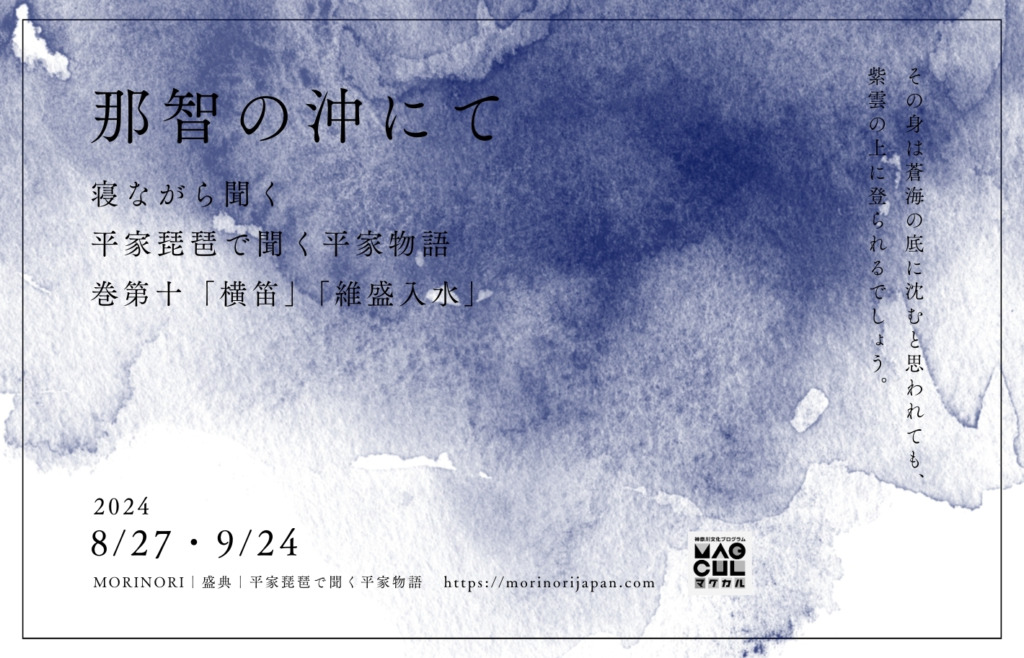
The Tale of the Heike continues with “Kouyanomaki”, “Koremorishukke”, “Kumanosankei” and “Koremorijusui” after “Yokobue”, but in the concert “Off the coast of Nachi”, “Koremorijusui” is recited after the Heikyoku “Yokobue”.
Off the coast of Nachi|The Tale of the Heike, listened to in one’s sleep by Heike biwa
Click here for the feature page
https://morinorijapan.com/nachinookinite
Thank you for reading this far.
I hope we meet again someday.

